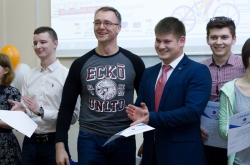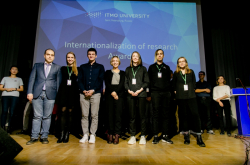No more tailings
In modern mining industry, the useful materials extracted from ore are called the concentrate. If its concentration is low, the bare ore is called tailings. They are seen as waste and are to be eliminated by different methods. To do that, ore is crushed, melted, roasted, leached, etc. Yet, there are also radiometric methods to beneficiating the ore, which allow separating the useful materials from the bare ore without destroying it. Artem Alekhin and Alexander Chertov, residents of the Future Technologies accelerator, used one of such methods as basis for their express analyzer of raw minerals.
"One of the methods for beneficiating solid minerals is optical — or, as it’s called in Russia, photometrical separation. This method has relatively high productivity and is ecologically clean. The method is based on analyzing the differences in the ore's components by color, transparency, luster and other "visual" properties using machine vision and image processing technologies. It is not new and there are already corresponding devices in the market, the so-called optical separators, mostly produced by German companies. Yet, after analyzing them and studying the marketing strategy of their manufacturers, we understood that they are imperfect in several ways. Thus, we've decided on creating our own device", shares Alexander Chertov.
Karalveyem Mine. Credit: flickr.com
According to developers from ITMO University, German optical separators are both expensive (they cost hundreds of thousands Euros), and not user-friendly: they are sold with enclosed technical support, so the user doesn't really get the whole info about the device. Thus, he can't fully adjust the device to his purposes. Then again, re-adjusting the settings can become necessary at any time, as properties of ore from even the same place can be really irregular. Also, such large devices can't be timely tested in the field. As for developers from St. Petersburg, they offer both a laboratory device and a portable device, which will be of the size of a handgun.
How it works
The device's operating principle is unique — it uses different algorithms to analyze an object's visual properties. The device can represent even the most complex inhomogeneous surfaces as color maps.
"The uniqueness of our device is not its construction or element base, but the approaches and principles it uses: how to light the object, how to form the image, how to process it. First, an object or a group of objects is placed inside the analysis area, similar to how it works with microscopes. Then, you see the image on a display, magnified, if necessary, and then the image is processed. Pre-processing and analysis is conducted using the different algorithms we've developed, all of which are unique and change depending on the type of the raw mineral, the task and working conditions", explains Alexandr Chertov.
ITMO University. Artem Alekhin
"If we study colored objects, that is one thing, if they are transparent — another, there are also cases when the objects are really similar in color. If we take visually similar materials of entirely different type, the operation principles will be different, as well. For instance, we can analyze semi-transparent object in more detail so as to define their inner structure. Thus, for every type of raw minerals we have a special algorithm and type of analysis", adds Artem Alekhin.
Why analyzing ore and food is not much different?
The work on the device started in 2013 with a project on creating the algorithms that later became the core of its operating principle. Since then, the project's team has already defended four theses. Later, thanks to a grant from the "UMNIK" program, they got funds for their first prototype. As of now, the team works on an application for the "START" program of the Innovation Support Foundation. They are planning to create the first prototype within a year. The team also searches for investors and plans on broadening the application field of their invention. Recently, they've found out that it can be used in the food industry, as well.
"When we go to a shop, we choose products according to taste, smell, color and appearance. What is most interesting is that in laboratories on food production plants the use the same properties for quality control. After we've studied the regulatory documents for food production, we understood that the visual properties are the same as what we used for mining industry. For instance, according to the State standard specification, the color of beef muscular tissue of 1st and 2ns class can be from light red to red. We all perceive colors differently, so visual evaluation is subjective — yet, our device can change it", marks Alexander Chertov.
Credit: piqsels.com
According to Artem Alekhin, all the concepts for color and visual analysis that they use for studying raw minerals can be used for many food products. Together with the Department of Meat and Fish Processing and Refrigeration, they've already tried analyzing meat of different animals, and tried analyzing eggs, fish and caviar together with Saint-Petersburg State Agrarian University.
"We already have some results. Though we began with solid minerals only, now we see other promising opportunities, as in food industry. This is really important, as optical separation of mineral ore is a narrow field, whereas food industry is a large and promising market", concludes Mr. Chertov.
You can learn more about the project during the DemoDay of the Future Technologies accelerator, which will take place at ITMO University on February, 18.





